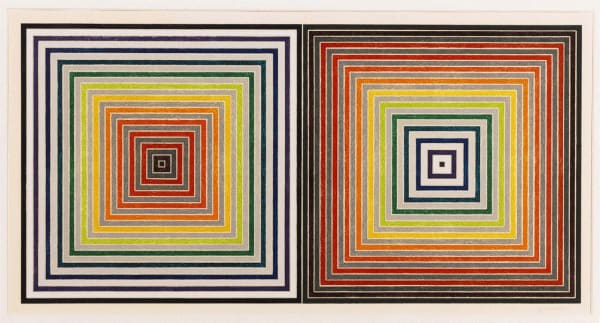All I want anyone to get out of my [works] and all I ever get out of them is the fact that you can see the whole idea without any confusion. What you see is what you see.
– Frank Stella, 1964
Frank Stella, whose career spanned nearly seven decades, died at his home in Manhattan’s West Village on Saturday, May 4. He was 87. His wife, Dr. Harriet E. McGurk, said the cause was lymphoma.
Stella rose to prominence as an artist when he was just 23 years old. He was born and raised in Malden, Massachusetts. His mother had attended art school and painted landscapes, his father was a gynecologist. Stella began to study painting at the Phillips Academy in Massachusetts and went on to get a degree in history at Princeton.
When Stella moved to New York in the 1950s, he worked as a house painter to pay the rent. It was enamel house paint and a house painter's brush that he used to create the minimalist Black Paintings series that catapulted him to fame. The works were exhibited in several New York galleries and then included in the Sixteen Americans exhibit at the Museum of Modern Art in 1959.
The Black Paintings series gave rise to the Minimalist movement and had a profound effect on art in the mid-twentieth century. Stella, however, expanded his works to include colors, shapes and, in the last decades of his life, enormous sculptures.
Frank Stella: Imaginary places from Kenneth E Tyler Collection on Vimeo.
For more than thirty years, Stella worked with master printmaker, Kenneth Tyler. Beginning in the mid-1960s Stella created series of fine art prints, with each series focusing on a particular theme. Though Stella insisted that “what you see is what you see”, much of his work was imbued with sentiment:
One of his favorites works, he admitted, was Pergusa Three, from the Circuit Series, (available at Surovek Gallery). Stella traveled around the world, visiting racetracks and creating the Circuit Series. Pergusa is a track in Italy, the country of origin of the Stella family. Stella confesses this top-pick choice toward the end of this video:
Polar Co-ordinates for Ronnie Peterson was created by Stella as an homage to his friend, Ronnie Peterson, the Swedish race car driver who died after a tragic accident at the Grand Prix in Monza in 1978.
Stella will be remembered for the thoughtful, creative and many public works that grace major venues around the world, including 7 World Trade Center.
Frank Stella is survived by his wife, five children and five grandchildren.
References:
William Grimes. Frank Stella, Towering Artist and Master of Reinvention, Dies at 87. The New York Times. May 4, 2024.
Deborah Solomon. Frank Stella Went From Bauhaus to Fun House. The New York Times. May 5, 2024.
Frank Stella (1936–2024). Art Forum/News Desk. May 6, 2024.




